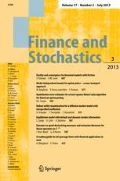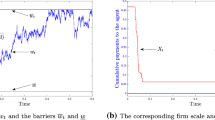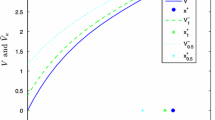Abstract
We study a dynamic corporate finance contracting model in which the firm’s profitability fluctuates and is impacted by the unobservable managerial effort. Thereby, we introduce in an agency framework the issue of strategic liquidation. We show that the principal’s problem takes the form of a two-dimensional fully degenerate Markov control problem. We prove regularity properties of the value function and derive explicitly the optimal contract that implements full effort. Our regularity results appear in some recent studies, but with heuristic proofs that do not clarify the importance of the regularity of the value function at the boundaries.
Similar content being viewed by others
Notes
We review the literature below, at the end of this section.
In DeMarzo and Sannikov [8], cash flows are modelled as the increment of an arithmetic Brownian motion with an unknown drift. Optimal liquidation occurs when beliefs about the constant drift fall to an endogenous threshold. The principal can ensure optimal liquidation once the agent has established a sufficiently high record. In He [11], liquidation is always inefficient. When the agent establishes a sufficiently high record, the principal can design payments in such a way that the continuation value of the agent becomes proportional to the firm size that follows a geometric Brownian motion. Thus, the continuation value of the agent remains always positive and liquidation never occurs.
For instance, in standard models with i.i.d. shocks, payouts to the manager take place when the agent’s continuation value reaches a payout threshold (see, for instance, Biais et al. [1]).
This also holds true for DeMarzo and Sannikov [8].
References
Biais, B., Mariotti, T., Rochet, J.C.: Dynamic financial contracting. In: Acemoglu, D., et al. (eds.) Advances in Economics and Econometrics: Tenth World Congress of the Econometric Society, vol. 1, pp. 125–172. Cambridge University Press, Cambridge (2013)
Biais, B., Mariotti, T., Plantin, G., Rochet, J.C.: Dynamic security design: convergence to continuous time and asset pricing implications. Rev. Econ. Stud. 74, 345–390 (2007)
Borodin, A., Salminen, P.: Handbook on Brownian Motion. Facts and Formulae. Birkhäuser, Basel (1996)
Cvitanić, J., Possamaï, D., Touzi, N.: Moral hazard in dynamic risk management. Manag. Sci. 63, 3328–3346 (2016)
Cvitanić, J., Possamaï, D., Touzi, N.: Dynamic programming approach to principal–agent problems. Finance Stoch. 22, 1–37 (2018)
Daskalopoulos, P., Feehan, P.M.N.: \(C^{1,1}\) regularity for degenerate elliptic obstacle problems. J. Differ. Equ. 260, 5043–5074 (2016)
DeMarzo, P.M., Sannikov, Y.: Optimal security design and dynamic capital structure in a continuous time agency model. J. Finance 61, 2681–2724 (2006)
DeMarzo, P.M., Sannikov, Y.: Learning, termination, and payout policy in dynamic incentive contracts. Rev. Econ. Stud. 84, 182–236 (2017)
Dixit, A.K., Pindyck, R.S.: Investment Under Uncertainty. Princeton University Press, Princeton (1994)
Faingold, E., Vasama, S.: Real options and dynamic incentives. Working paper (2014). Available online at http://gtcenter.org/Archive/2014/Conf/Vasama1855.pdf
He, Z.: Optimal executive compensation when firm size follows geometric Brownian motion. Rev. Financ. Stud. 22, 859–892 (2009)
Hynd, R.: Analysis of Hamilton–Jacobi–Bellman equations arising in stochastic singular control. ESAIM Control Optim. Calc. Var. 19, 112–128 (2013)
Hynd, R.: An eigenvalue problem for a fully nonlinear elliptic equation with gradient constraint. Calc. Var. Partial Differ. Equ. 56(34), 1–31 (2017)
Hynd, R., Mawi, H.: On Hamilton–Jacobi–Bellman equations with convex gradient constraints. Interfaces Free Bound. 18, 291–315 (2016)
Lamberton, D., Terenzi, G.: Variational formulation of American option prices in the Heston model (2017). arXiv:1711.11311
Krylov, N.V.: Lectures on Elliptic and Parabolic Equations in Sobolev Spaces. Graduate Studies in Mathematics. AMS, Providence (2008)
Pham, H.: On the smooth-fit property for one-dimensional optimal switching problem. In: Donati-Martin, C., et al. (eds.) Séminaire de Probabilités XL. Lecture Notes in Mathematics, vol. 1899, pp. 187–199. Springer, Berlin (2007)
Pham, H.: Continuous-Time Stochastic Control and Optimization with Financial Applications. Springer, Berlin (2010)
Rogers, L.C.G., Williams, R.: Diffusions, Markov Processes and Martingales, vol. 2. Cambridge University Press, Cambridge (2000)
Sannikov, Y.: A continuous-time version of the principal–agent problem. Rev. Econ. Stud. 75, 957–984 (2008)
Soner, H.M., Shreve, S.E.: Regularity of the value function for a two-dimensional singular stochastic control problem. SIAM J. Control Optim. 27, 876–907 (1989)
Strulovici, B.: Contracts, information persistence, and renegotiation. Working paper, Northwestern University (2011). Available online at http://faculty.wcas.northwestern.edu/~bhs675/RMP.pdf
Strulovici, B., Szydlowski, M.: On the smoothness of value functions and the existence of optimal strategies in diffusion models. J. Econ. Theory 159, 1016–1055 (2015)
Vasama, S.: On moral hazard and persistent private information. Discussion paper No. 15/2017, Bank of Finland Research (2017). Available online at https://papers.ssrn.com/sol3/papers.cfm?abstract_id=3013567
Williams, N.: Persistent private information. Econometrica 79, 1233–1275 (2011)
Zhang, Y.: Dynamic contracting with persistent shocks. J. Econ. Theory 144, 635–675 (2009)
Zhu, J.Y.: Optimal contracts with shirking. Rev. Econ. Stud. 80, 812–839 (2013)
Author information
Authors and Affiliations
Corresponding author
Additional information
We thank seminar audiences at ENPC, INRIA and UPEMLV. We thank the Co-Editor Jakša Cvitanić as well as an anonymous referee for very fruitful comments. We also thank participants at the conference “Information in Finance and Assurance”, Paris, June 2015, “Robust Finance”, Bielefeld, May 2016, “Frontiers for Stochastic Modelling for Finance”, Padova, February 2016. We are indebted to Laurent Miclo for suggesting us the use of the Doob \(h\)-transform. Financial support from the Chair IDEI-SCOR under the aegis of Fondation du Risque Market Risk and Value Creation and ANR project PACMAN (ANR-16-CE05-0027) are gratefully acknowledged.
Appendix
Appendix
Proof of Lemma 4.4
First observe that for every pair \((x,w) \in (x^{*},+\infty )\times (0,+\infty )\), there is some \(C>0\) such that \(u(x,w)\le C(1+x)\). Indeed,
Therefore, Lemma 4.4 holds for \(w \ge 1\). Let us now consider \(w \in (0,1)\). We decompose \(u(x,w)\) as \(u(x,w)=u_{1}(x,w)+u _{2}(x,w)\), with
where \(\tau_{1}^{w}=\inf \{ t \ge 0: W_{t}^{w}=1 \}\). On the event \(\{\tau_{0}^{w} < \tau_{1}^{w} \}\), we have for every \(t \le \tau^{*} \wedge \tau_{0}^{w} < \tau_{1}^{w}\) the inequality \(X_{t} \le \frac{1}{ \lambda } + x\). Therefore,
Conditioning the process \((W_{t})_{t \in [0,\tau_{1}^{w}]}\) on the event \(\{\tau_{0}^{w} < \tau_{1}^{w} \}\) and using Doob’s \(h\)-transform (see Rogers and Williams [19, Chap. IV, Sect. 39] for a definition) makes \((W_{t})_{t \in [0,\tau_{1}^{w}]}\) a diffusion absorbed at 0 with generator
where
Let us denote \(\tilde{\tau }_{0}^{w}=\inf \{t \ge 0:\tilde{W}_{t}^{w}=0 \}\), where
We have
The function \(\tilde{\phi }\) satisfies
with \(\tilde{\phi }(0)=0\). A computation shows that \(rw+\lambda \sigma \frac{h^{\prime }(w)}{h(w)}<0\), and because \(\tilde{\phi }\) is nondecreasing, we get that \(\tilde{\phi }\) is convex. We deduce that \(\tilde{\phi }(w)\le C w\) for some positive constant \(C\) which implies \(u_{1}(x,w)\le C(1+x)w\). Now, we decompose \(u_{2}\) as
Because for every \(s \le \tau_{1}^{w}\), we have \(X_{s}\le \frac{1}{ \lambda } +x\), it follows that
Finally, the strong Markov property implies
where the first inequality holds because \(u(x^{*},W_{\tau^{*}})=0\). This ends the proof of Lemma 4.4. □
Proof of Proposition 4.5
We show that \(u(x,w) = c (x) \, w + o(w)\) for \(w\) sufficiently small, where \(c (x)\) is a real constant. This will prove that \(\frac{\partial u}{\partial w} (x,0)< +\infty \).
We have
First, observe that
where we set \(\ell (w) =\mathbb{E}^{0} [e^{-r\tau_{0}^{w}}]\). Following [3, Chap. 2, Sect. 1.10], we introduce the function \(\phi \) defined as the nonincreasing fundamental solution on ℝ of
The function \(\ell \) coincides with \(\phi \) on \((0,+\infty )\), and in particular \(\ell \) is twice continuously differentiable over \((0, \infty )\) with \(\ell^{\prime }(0+)<+\infty \). It follows that for \(w\) small enough, \(1 - \ell (w) = - \ell^{\prime }(0+) \, w = o(w)\).
We now study the second term on the right-hand side of (A.2). Let us define the \(\mathbb{P}^{0}\)-uniformly integrable martingale
The optional sampling theorem gives \(\mathbb{E}^{0}[N_{\tau_{0}^{w} \wedge T}]=0\). Then, letting \(T \to +\infty \),
Observe that \(e^{-rt} W_{t} = w+\lambda \sigma N_{t}\), \(t \geq 0\), is thus under \(\mathbb{P}^{0}\) a uniformly integrable martingale. Using the dynamics of \((W_{t})\), we deduce that
is a \(\mathbb{P}^{0}\)-uniformly integrable martingale. Thus the optional sampling theorem yields
Letting \(T\) tend to \(\infty \), we obtain
Using (A.3) and (A.4), one gets
where the last equality follows from the strong Markov property. Now, it remains to prove that
for \(w\) small enough. First, we show that the function \(w\mapsto w \ell (w)\) is bounded. Let us consider the real function \(k(w) = (\int _{w}^{\infty }e^{-\frac{r}{\sigma^{2}\lambda^{2}} t^{2}} \, dt) / ( \int_{0}^{\infty }e^{-\frac{r}{\sigma^{2}\lambda^{2}} t^{2}} \, dt)\) which is the smooth solution to
Note that the function \(\theta =k-\ell \) is twice continuously differentiable, bounded over \((0, \infty )\) and satisfies \(\theta (0) = \lim_{w\to +\infty }\theta (w) = 0\) together with
Then the process \((\theta (W_{t}))_{t \geq 0}\) is a bounded \(\mathbb{P}^{0}\)-supermartingale and thus for every \(T>0\),
Letting \(T \to +\infty \), we conclude that \(\theta (w) \ge 0\) because \(\theta \) is bounded with \(\theta (0)=0\). It follows that \(\ell (w) w \leq k(w) w\) over \([0, \infty )\). We observe that \(\lim_{w \to \infty } w k(w) =0\) and thus \(\lim_{w \to \infty } w \ell (w) =0\). Therefore, the function \(w \mapsto w \ell (w) \) is bounded on \([0, \infty )\) and the function \(g\) is well defined.
Assume for a while the existence of a bounded \(C^{2}\) solution \(f\) on ℝ to the differential equation
Itô’s formula yields for every \(T>0\) that
Observe that because \(f(0)=0\),
The monotone convergence theorem gives
Letting \(T\) tend to \(+\infty \) in (A.6), we have that \(g\) coincides with \(f\) on \((0,+\infty )\). Therefore, \(g\) is a bounded, twice continuously differentiable function over \((0, \infty )\) and thus \(g(w) = g' (0+) w + o(w)\).
The existence of a bounded solution of (A.5) comes from the general form of solutions given by the method of variation of constants,
where \(J(x)=\frac{2}{\sigma^{2}}(\ell (x)-x\ell^{\prime }(x))\) is the Wronskian. Because we have \(\ell \le k\) and \(J(x)=Ce^{-\frac{r}{ \sigma^{2}\lambda^{2}}x^{2}}\) (see [3, Chap. 2, Sect. 1.11]), the two integrals \(\int_{0}^{x} \frac{u^{2}\ell (u)}{J(u)}\,du\) and \(\int_{0}^{x} \frac{u\ell^{2}(u)}{J(u)}\,du\) converge for \(x \to \infty \). Then, it suffices to choose \(\beta =-\int_{0}^{\infty }\frac{u ^{2}\ell (u)}{J(u)}\,du\) and \(\alpha =0\) to conclude.
Summing up our results, we have obtained that
Moreover, observe that \(\eta \) is a continuous bounded function on \((0,+\infty )\).
We now turn to the second term of (A.1). We show that for \(w\) sufficiently small,
where \(C\) is a constant that may depend on \(x\). The strong Markov property yields
where the last equality used again the optional sampling theorem with the martingale \((e^{-rt} W_{t})_{t \geq 0}\) because \(\tau^{*}\) is almost surely finite. We end the proof by showing that
for sufficiently small \(w\). For every \(\varepsilon >0\), there is some \(\delta >0\) such that \(\vert \eta (w) \vert \le \varepsilon \) for all \(w < \delta \). Now, fix \(\varepsilon >0\), \(w<\delta \) and introduce the stopping time
We have
Proceeding analogously as in the proof of Lemma 4.4, we define on the set \(\{\tau_{\delta }^{w} < \tau_{0}^{w}\}\) the diffusion \((\hat{W}_{t})_{t \le \tau_{0}}\) absorbed at \(\delta \) by using Doob’s \(h\)-transform and obtain
Now, both expressions \(\mathbb{P}^{0}[ \tau_{\delta }^{w} < \tau_{0} ^{w}]\) and \(\mathbb{E}^{0} [ e^{-r\hat{\tau }_{\delta }^{w}} \hat{W} _{\hat{\tau }_{\delta }^{w}}]= \delta \mathbb{E}^{0} [ e^{-r \hat{\tau }_{\delta }^{w}} ]\) converge to zero when \(w \to 0\). Moreover, as in Lemma 4.4, \(\mathbb{P}^{0}[ \tau_{\delta }^{w} < \tau_{0}^{w}]=Cw+o(w)\). This ends the proof that \(\frac{\partial u }{\partial w}(x,0)\) exists and is finite. Furthermore, we observe that the function \(x \mapsto \frac{\partial u }{\partial w}(x,0)\) is nondecreasing because \(x \mapsto u(x,w)\) is nondecreasing.
With these preparations, we are now ready to prove (i)–(iii).
(i) We have for \(\varepsilon >0\) that
where \(\tau_{R}^{\varepsilon }=\inf \{t \ge 0:(x + \sigma Z_{t}, w + \varepsilon + \int_{0}^{t} r W_{s} \, ds + \lambda \sigma Z_{t}) \notin R\} \ge \tau_{R}\). The strong Markov property gives for the first term
Using \(u(x^{*},w)=0\) for all \(w>0\), we get
Now, observe that \(W^{w+\varepsilon }_{\tau_{0}}=\varepsilon e^{r \tau _{0}^{w}}\) and thus
Because we have just proved that \(\frac{\partial u}{\partial w}(x,0)\) exists for every \(x>0\), we know that the random variables converge to almost surely when \(\varepsilon \) tends to zero. Moreover, up to a constant, they are bounded above by \(1+X_{\tau^{w} _{0}}\) by Lemma 4.4. Now observe that
on the set \(\{\tau^{*}\ge \tau^{w}_{0} \}\) and thus \(1+X_{\tau^{w} _{0}}\) is bounded on this set. Then the dominated convergence theorem yields assertion (i) by letting \(\varepsilon \) tend to zero in (A.7).
(ii) First, we prove that \(X^{x}_{\tau_{0}^{w_{0}}} \ge X^{x}_{\tau _{0}^{w_{1}}}\) for any \(w_{0} \le w_{1}\) on the set \(\{ \tau_{0}^{w _{1}}<+\infty \}\). Note that \(\tau_{0}^{w_{0}} \le \tau_{0}^{w_{1}}\) almost surely for \(w_{0} \le w_{1}\). We integrate \(\lambda dX_{t} = dW _{t}-rW_{t}\,dt \) on the interval \((\tau_{0}^{w_{0}},\tau_{0}^{w_{1}})\) on the set \(\{ \tau_{0}^{w_{1}}<+\infty \}\). We obtain
According to assertion (i),
where the last inequality comes from the fact that \(x \mapsto \frac{ \partial u}{\partial w}(x,0)\) is nondecreasing. Thus, the function \(w \mapsto \frac{\partial u}{\partial w}\) is a decreasing function. Because we know that \(u\) is twice continuously differentiable over \(R\), we get assertion (ii).
(iii) Let us consider \(f\) defined as
To prove assertion (iii), we show that \(f\) is nonincreasing for any \(c\) such that \((x,\lambda (x-c))\) is in \(R\). Take \(x_{0} \le x_{1}\) and \(w_{i}=\lambda (x_{i}-c)\) for \(i=0,1\). From assertion (ii), we have
We show that or, equivalently, that
On the set \(\{ \tau_{0}^{w_{0}} > \tau^{*,x_{0}} \} \), we have
Therefore,
and thus for all \(t \ge \tau^{*, x_{0}} \), we have \(W_{t}^{w_{1}} \ge \lambda (X_{t}^{x_{1}}-x^{*})\). This implies \(\tau_{0}^{w_{1}} > \tau^{*, x_{1}}\). Consequently,
Proceeding as previously, on the set \(\{\tau_{0}^{w_{1}} < +\infty \}\), we have
Thus,
□
Rights and permissions
About this article
Cite this article
Décamps, JP., Villeneuve, S. A two-dimensional control problem arising from dynamic contracting theory. Finance Stoch 23, 1–28 (2019). https://doi.org/10.1007/s00780-018-0376-4
Received:
Accepted:
Published:
Issue Date:
DOI: https://doi.org/10.1007/s00780-018-0376-4




